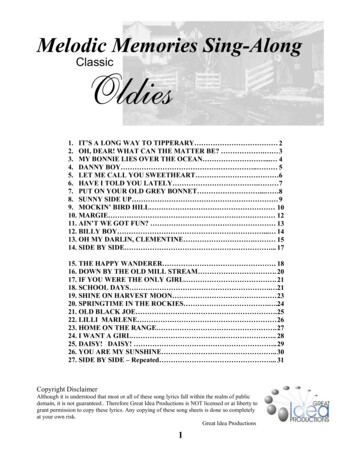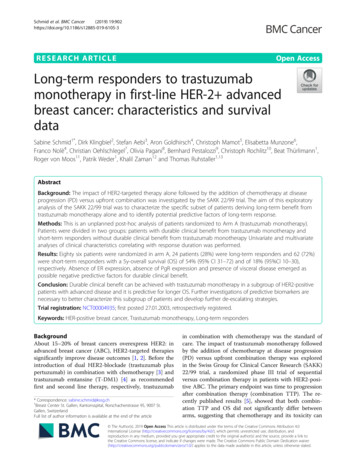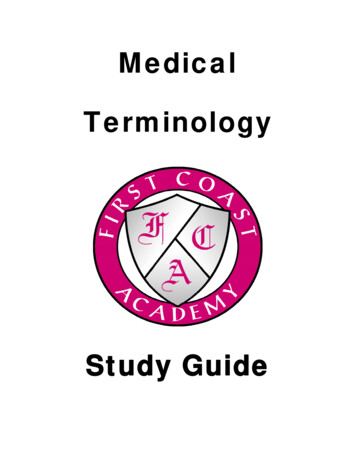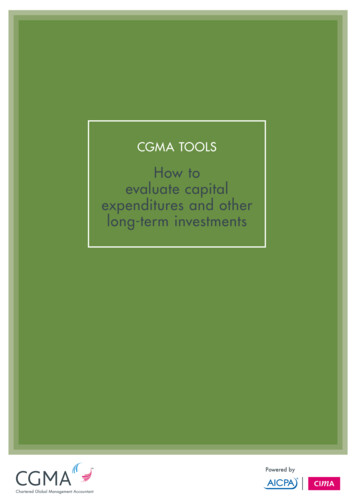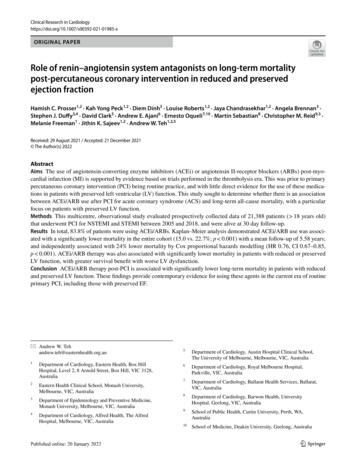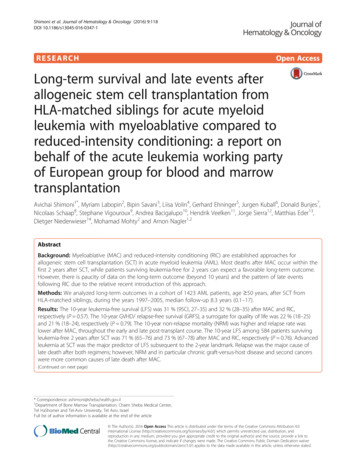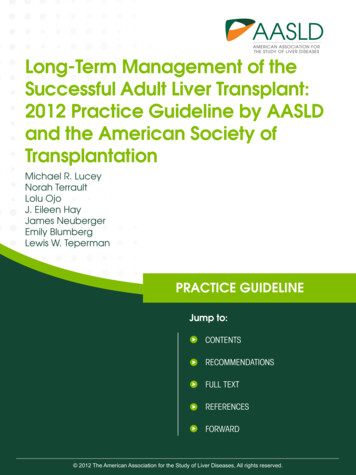
Transcription
Long-Term Management of theSuccessful Adult Liver Transplant:2012 Practice Guideline by AASLDand the American Society ofTransplantationMichael R. LuceyNorah TerraultLolu OjoJ. Eileen HayJames NeubergerEmily BlumbergLewis W. TepermanPRACTICE GUIDELINEJump to:CONTENTSRECOMMENDATIONSFULL TEXTREFERENCESFORWARD 2012 The American Association for the Study of Liver Diseases, All rights reserved.
Long-Term Management of Adult Liver Transplant:2012 Practice Guideline by AASLD and ASTAASLDPRACTICE GUIDELINECONTENTSRECOMMENDATIONSContentsFULL TEXTREFERENCESWEB SITE(click section title or page number)Recommendations and Rationales . . . . . . . . . . . . . . . . . . . . . . . . . . . . . . . . . . . . . . . . 3Full-text Guideline. . . . . . . . . . . . . . . . . . . . . . . . . . . . . . . . . . . . . . . . . . . . . . . . . . 103Abbreviations. . . . . . . . . . . . . . . . . . . . . . . . . . . . . . . . . . . . . . . . . . . . . . . . . . . . . 104Preamble. . . . . . . . . . . . . . . . . . . . . . . . . . . . . . . . . . . . . . . . . . . . . . . . . . . . . . . . 105LT as a Treatment for End-stage Liver Disease / Mortality After LT / Morbidity After LT. . . . 106Complications of Portal Hypertension After LT. . . . . . . . . . . . . . . . . . . . . . . . . . . . . . . 108Liver Tests / Vascular Thrombosis. . . . . . . . . . . . . . . . . . . . . . . . . . . . . . . . . . . . . . . 109Immunosuppression. . . . . . . . . . . . . . . . . . . . . . . . . . . . . . . . . . . . . . . . . . . . . . . . 110Late Rejection. . . . . . . . . . . . . . . . . . . . . . . . . . . . . . . . . . . . . . . . . . . . . . . . . . . . . 111Promoting Health After LT. . . . . . . . . . . . . . . . . . . . . . . . . . . . . . . . . . . . . . . . . . . . . 113Bone Health. . . . . . . . . . . . . . . . . . . . . . . . . . . . . . . . . . . . . . . . . . . . . . . . . . . . . . 114Systemic Disease. . . . . . . . . . . . . . . . . . . . . . . . . . . . . . . . . . . . . . . . . . . . . . . . . . 115Nutrition and Obesity. . . . . . . . . . . . . . . . . . . . . . . . . . . . . . . . . . . . . . . . . . . . . . . . 119Oncology. . . . . . . . . . . . . . . . . . . . . . . . . . . . . . . . . . . . . . . . . . . . . . . . . . . . . . . . 120Reproductive Health . . . . . . . . . . . . . . . . . . . . . . . . . . . . . . . . . . . . . . . . . . . . . . . . 121Infectious Disease. . . . . . . . . . . . . . . . . . . . . . . . . . . . . . . . . . . . . . . . . . . . . . . . . . 123Immunizations. . . . . . . . . . . . . . . . . . . . . . . . . . . . . . . . . . . . . . . . . . . . . . . . . . . . 129Viral Hepatitis. . . . . . . . . . . . . . . . . . . . . . . . . . . . . . . . . . . . . . . . . . . . . . . . . . . . . 130PBC / PSC . . . . . . . . . . . . . . . . . . . . . . . . . . . . . . . . . . . . . . . . . . . . . . . . . . . . . . . 132Autoimmune Hepatitis (AIH) / Alcoholic Liver Disease (ALD). . . . . . . . . . . . . . . . . . . . 133NASH and NAFLD / Late Surgical Complications. . . . . . . . . . . . . . . . . . . . . . . . . . . . . 134References. . . . . . . . . . . . . . . . . . . . . . . . . . . . . . . . . . . . . . . . . . . . . . . . . . . . . . . 135USING, SEARCHING, AND PRINTING GUIDELINESThis document was designed for use on a varietyof devices using Adobe Acrobat Reader. Smallerscreens should be held horizontally. You may searchor print using your PDF viewer. Menu hyperlinks allowmovement between sections and to the guidelines onthe AASLD site. In Recommendations and Rationales,click on individual items to review specific rationales.BACKUse the top menu to return to the list. This file reflectsthe most recently approved language of the publishedguideline. Your feedback is welcome on the design andusability and will help guide future publications.Please email your commentsto adavisowino@aasld.orgor visit our social media pages.2 2012 The American Association for the Study of Liver Diseases, All rights reserved.FORWARD
Long-Term Management of Adult Liver Transplant:2012 Practice Guideline by AASLD and ASTAASLDPRACTICE GUIDELINECONTENTSRECOMMENDATIONSFULL TEXTREFERENCESWEB SITERecommendations and RationalesThis guideline includes 93 specific recommendations. Please click on a recommendation to review the relatedrationale and supporting evidence. See Table 1 for an explanation of the grading system for recommendations.1. The frequency of monitoring with liver testsshould be individualized by the transplantcenter according to the time from livertransplant (LT), the complications from LT,the stability of serial test results, and theunderlying cause (grade 1, level A).8. Rejection can be reliably diagnosed only onthe basis of liver histology; a biopsy sampleshould be taken before treatment initiationand classified according to the Banff criteria(grade 1, level A).9. Although the long-term withdrawal of allimmunosuppression can be achieved in asmall number of patients, this should beundertaken only with select recipients andunder close supervision (grade 2, level C).2. Depending on the pattern of liver tests,magnetic resonance imaging, computedtomography, endoscopic retrogradecholangiopancreatography, and sonographymay be appropriate (grade 1, level A).10. Frequent hand washing reduces the riskof infection with pathogens acquired bydirect contact, including Clostridium difficile,community-acquired viral infections, andpathogens found in soil (grade 1, level A).3. Liver histology should be obtained whenparenchymal injury is suspected as thecause of abnormal liver tests (grade 1, level A).4. Bilomas and biliary cast syndrome shouldbe managed in a center with expertise in LTmedicine, radiology, and biliary endoscopy(grade 1, level A).11. Shoes, socks, long-sleeve shirts, and longpants should be worn for activities that willinvolve soil exposure and tick exposure andalso to avoid unnecessary sun exposure(grade 1, level A).5. Hepatic artery thrombosis or stenosis ismost readily assessed initially by Dopplerultrasound, but angiography is usuallyrequired to confirm the diagnosis and plantherapy (grade 1, level B).12. During periods of maximalimmunosuppression, LT recipients shouldavoid crowds to minimize exposures torespiratory illnesses (grade 1, level A).6. Immunosuppressive drugs for LT recipientsshould be prescribed and monitored only bythose with knowledge and expertise in thatarea. The choice of agents will depend onmany factors, and no one regimen can berecommended for any patient(grade 2, level A).13. Work in high-risk areas, such asconstruction, animal care settings, gardening,landscaping, and farming, should bereviewed with the transplant team to developappropriate strategies for the prevention ofhigh-risk exposures (grade 2, level A).7. Every patient’s immunosuppressiveregimen should be reviewed at least every6 months and modified as required withthe goal of minimizing long-term toxicities(grade 1, level B).BACK14. LT recipients should avoid the consumptionof water from lakes and rivers(grade 1, level A).3 2012 The American Association for the Study of Liver Diseases, All rights reserved.FORWARD
Long-Term Management of Adult Liver Transplant:2012 Practice Guideline by AASLD and ASTAASLDPRACTICE GUIDELINECONTENTSRECOMMENDATIONSFULL TEXT15. LT recipients should avoid unpasteurizedmilk products and raw and undercookedeggs and meats (particularly uncookedpork, poultry, fish, and seafood; grade 1,level A).WEB SITE22. For female LT recipients of a childbearing age, preconception counselingabout contraception and the risks andoutcomes of pregnancy should start inthe pretransplant period and should bereinforced after transplantation(grade 1, level A).16. LT recipients should avoid high-risk pets,which include rodents, reptiles, chicks,ducklings, and birds (grade 1, level A).23. In the first 5 years after transplantation,screening by bone mineral density (BMD)should be done yearly for osteopenicpatients and every 2 to 3 years for patientswith normal BMD; thereafter, screeningdepends on the progression of BMD and onrisk factors (grade 2, level B).17. Travel by LT recipients, especially todeveloping countries, should be reviewedwith the transplant team a minimum of 2months before departure to determineoptimal strategies for the reduction oftravel-related risks (grade 1, level A).24. If osteopenic bone disease is confirmedor if atraumatic fractures are present,then patients should be assessed for riskfactors for bone loss; in particular, thisshould include an assessment of calciumintake and 25-hydroxy-vitamin D levels, anevaluation of gonadal and thyroid function,a full medication history, and thoracolumbarradiography (grade 1, level A).18. LT recipients should take precautions toprevent vector (including mosquito) -bornediseases. These include avoiding going outduring peak mosquito feeding times (dawnand dusk)and using N,N-diethyl-metatoluamide–containing insect repellants(grade 1, level A).19. LT recipients should undertake a thoroughreview of hobbies to assess potentialinfectious disease risks, particularly thoseassociated with outdoor hobbies(grade 2, level A).25. The osteopenic LT recipient should performregular weight-bearing exercise and receivecalcium and vitamin D supplements(grade 1, level A).20. All LT recipients should be educated aboutthe importance of sun avoidance and sunprotection through the use of a sun blockwith a sun protection factor of at least 15and protective clothing. They should beencouraged to examine their skin on aregular basis and report any suspicious orconcerning lesions to their physicians(grade 1, level A).26. Bisphosphonate therapy should beconsidered in LT recipients withosteoporosis or recent fractures(grade 1, level A).27. Monitoring of renal function in LT recipientsfor the detection and management ofchronic kidney disease should usean estimating equation to evaluate theglomerular filtration rate (grade 1, level B).21. Because of the strong association of lung,head, and neck cancers with smoking, thesustained cessation of smoking is the mostimportant preventative intervention(grade 1, level A).BACKREFERENCES28. Urinary protein quantification using theconcentration ratio of protein to creatinine ina spot urine specimen should be evaluatedat least once yearly (grade 1, level B).4 2012 The American Association for the Study of Liver Diseases, All rights reserved.FORWARD
Long-Term Management of Adult Liver Transplant:2012 Practice Guideline by AASLD and ASTAASLDPRACTICE GUIDELINECONTENTSRECOMMENDATIONSFULL TEXT29. The reduction or withdrawal ofcalcineurin inhibitor (CNI) associatedimmunosuppression is an appropriateresponse to the development of chronickidney disease in LT recipients(grade 1, level A).WEB SITE36. Angiotensin-converting enzyme inhibitors,angiotensin receptor blockers, and directrenin inhibitors should be used as first-lineantihypertensive therapy in LT recipients withdiabetes mellitus, chronic kidney disease,and/or significant proteinuria(grade 1, level A).30. Kidney transplantation from deceased orliving donors is beneficial in improvingsurvival and should be considered theoptimal therapy for LT recipients whodevelop end-stage renal disease(grade 1, level A).37. The measurement of blood lipids after a14-hour fast is recommended annuallyfor healthy LT recipients. An elevatedlow-density lipoprotein (LDL) cholesterollevel 100 mg/dL, with or withouthypertriglyceridemia, requires therapy. Iftherapeutic lifestyle and dietary changesare not enough, statin therapy should beintroduced. Suboptimal control with statinscan be improved by the addition of ezetimibe(grade 2, level B).31. The treatment of diabetes mellitus after LTshould aim for a hemoglobin A1c (HbA1c)target goal of 7.0% with a combination oflifestyle modifications and pharmacologicalagents as appropriate (grade 1, level B).32. When high-dose corticosteroids areadministered, insulin therapy is the mosteffective and safest agent with which tocontrol hyperglycemia; however, as theinterval from LT extends, patients with newonset diabetes mellitus may experience adecline in insulin requirements, and oralhypoglycemic agents may be appropriate ifallograft function is normal (grade 1, level C).38. Isolated hypertriglyceridemia is first treatedwith omega-3 fatty acids (up to 4 g dailyif tolerated). If this is not sufficient forcontrol, gemfibrozil or fenofibrate can beadded, although patients must be followedcarefully for side effects, especially with theconcomitant use of statins and calcineurininhibitors (grade 2, level C).39. All LT patients require ongoing dietarycounseling to avoid obesity(grade 1, level C).33. Metformin or sulfonylureas may be usedin LT recipients with normal renal function,whereas sulfonylureas such as glipizide andglimepiride are preferable if there is anydeterioration of renal function(grade 1, level C).40. Among LT recipients who become severelyor morbidly obese and fail behavioral weightloss programs, bariatric surgery may beconsidered, although the optimal procedureand its timing with respect to transplantationremain to be defined (grade 1, level C).34. Consideration can be given to theconversion of immunosuppression fromtacrolimus to cyclosporine in LT recipientswith poor glycemic control (grade 2, level B).41. All LT recipients should see a dermatologistafter transplantation to assess cutaneouslesions, with at least an annual evaluationby a dermatologist 5 years or more aftertransplantation (grade 1, level A).35. The treatment of hypertension should aimfor a target goal of 130/80 mm Hg with acombination of lifestyle modifications andpharmacological agents as appropriate(grade 1, level A).BACKREFERENCES5 2012 The American Association for the Study of Liver Diseases, All rights reserved.FORWARD
Long-Term Management of Adult Liver Transplant:2012 Practice Guideline by AASLD and ASTAASLDPRACTICE GUIDELINECONTENTSRECOMMENDATIONSFULL TEXT42. Patients with primary sclerosing cholangitisand inflammatory bowel disease or otherestablished risk factors for colorectalcancer should undergo an annual screeningcolonoscopy with biopsies. Colectomy,including continence-preserving pouchoperations, should be considered whencolonic biopsy reveals dysplasia.(grade 1, level B).WEB SITE49. Allograft function and calcineurin inhibitorserum levels are monitored every 4 weeksuntil 32 weeks, then every 2 weeks, and thenweekly until delivery (grade 1, level B).50. Contraception should begin before theresumption of sexual activity, although noparticular form of contraception can berecommended over another(grade 2, level B).43. For patients without prior hepatocellularcarcinoma (HCC) who develop recurrentcirrhosis of the allograft, surveillance forde novo HCC should be undertaken withabdominal imaging every 6 to 12 months(grade 1, level A).51. An assessment for infections followingLT should take into account the intensityof immunosuppression, the timing of thepresentation, the environmental and donorexposures, the recipient’s history of bothsymptomatic and latent infections, and theutilization of prophylactic antimicrobials andimmunizations (grade 1, level A).44. An immunosuppressant regimen thatincludes sirolimus (started several weeksafter transplantation) should be consideredfor patients undergoing transplantation forhepatocellular carcinoma (grade 2, level B).52. Attention should be paid to potentialdrug interactions when new antimicrobialtherapies are initiated (grade 1, level A).45. Resection or ablation is usually the treatmentof choice for a solitary extrahepaticmetastasis or an intrahepatic recurrence ofhepatocellular carcinoma (grade 1, level B).53. High-risk recipients (cytomegalovirusseronegative recipients of cytomegalovirusseropositive donor organs) shouldreceive prophylaxis with ganciclovir orvalganciclovir for a minimum of 3 monthsafter transplantation (grade 1, level B).46. Pregnancy in an LT recipient should bemanaged by a high-risk obstetrician incoordination with the transplant hepatologist(grade 1, level C).54. The treatment of LT recipients withcytomegalovirus should be maintained untilviremia and all symptoms have resolved(grade 2, level B).47. Pregnancy should be delayed for 1 yearafter LT and occur at a time with good,stable allograft function, with maintenanceimmunosuppression, and with good controlof any medical complications such ashypertension and diabetes (grade 1, level B).55. Prophylaxis against cytomegalovirus shouldbe resumed whenever LT recipients receiveanti-lymphocyte therapy for the treatment ofrejection and should be continued for 1 to 3months after the treatment of rejection(grade 2, level B).48. The ideal immunosuppression for pregnancyis tacrolimus monotherapy, which should bemaintained at therapeutic levels throughoutpregnancy; cyclosporine, azathioprine, andprednisone may also be used if they arenecessary (grade 1, level B).BACKREFERENCES6 2012 The American Association for the Study of Liver Diseases, All rights reserved.FORWARD
Long-Term Management of Adult Liver Transplant:2012 Practice Guideline by AASLD and ASTAASLDPRACTICE GUIDELINECONTENTSRECOMMENDATIONSFULL TEXT56. The treatment of a cytomegalovirusinfection should consist of the following:a. Consideration of immunosuppressionreduction. b. High-dose intravenousganciclovir or oral valganciclovir inindividuals with mild to moderate diseasewithout gastrointestinal involvement ora reduced capacity for absorption. c. Aminimum of 2 weeks of treatment. Treatmentshould be continued to complete theresolution of all symptoms and viremia(grade 1, level A).REFERENCESWEB SITE60. The diagnosis of fungal infections mayrequire diagnostic biopsy for pathologicaland microbiological confirmation (grade 1,level A). a. Blood cultures are most helpfulfor the diagnosis of Candida bloodstreaminfections (class 1, level B) and Blastomyces(grade 1, level B). b. Cryptococcalantigen testing of cerebrospinal fluid orblood is most helpful for the diagnosis ofCryptococcus (grade 1, level B). c. Urinaryhistoplasmosis and Blastomyces antigensare useful for the diagnosis of disseminatedhistoplasmosis and blastomycosis,respectively (grade 1, level B).57. Resistant virus should be suspectedin patients with a history of prolongedganciclovir or valganciclovir exposure whohave a persistent or progressive infectiondespite treatment with high-dose intravenousganciclovir (grade 1, level A). In suchinstances, genotypic assays should beperformed, and consideration should begiven to the initiation of foscarnet with or insubstitution for ganciclovir (grade 1, level B).61. A cautious reduction of immunosuppressionshould be initiated to prevent immunereconstitution syndrome, especially forcryptococcal infections (grade 1, level B).62. All LT recipients should receive prophylaxisagainst P. jirovecii with trimethoprimsulphamethoxazole (single strengthdaily or double strength 3 times perweek) for a minimum of 6 to 12 monthsafter transplantation (grade 1, level A).Atovaquone and dapsone are the preferredalternatives for patients who are intolerant oftrimethoprim-sulfamethoxazole(grade 1, level B).58. Posttransplant lymphoproliferative disorder(PTLD) should be considered in LT recipients(especially high-risk individuals) who presentwith unexplained fever, lymphadenopathy, orcytopenias (grade 1, level A).59. Although Epstein-Barr virus (EBV) maybe associated with the development ofposttransplant lymphoproliferative disorder(PTLD), the detection of EBV viremia is notdiagnostic for PTLD; a histopathologicaldiagnosis is required (grade 1, level A).63. Trimethoprim-sulphamethoxazole is the drugof choice for the treatment of P. jiroveciipneumonia. Intravenous pentamidine is thepreferred alternative for patients intolerant oftrimethoprim-sulphamethoxazole with moresevere infections (grade 1, level A).64. Patients with clinical signs and symptoms orradiological features suggestive of P. jiroveciipneumonia should undergo sputum samplingor bronchoalveolar lavage with a cytologicalexamination using a silver or Giemsa stain,polymerase chain reaction, or a specificantibody stain to identify the organism(grade 1, level A).BACK7 2012 The American Association for the Study of Liver Diseases, All rights reserved.FORWARD
Long-Term Management of Adult Liver Transplant:2012 Practice Guideline by AASLD and ASTAASLDPRACTICE GUIDELINECONTENTSRECOMMENDATIONSFULL TEXT65. The treatment of active tuberculosis(TB) should include the initiation of a4-drug regimen using isoniazid, rifampin,pyrazinamide, and ethambutol (underthe assumption of susceptible TB) withadjustments in accordance with subsequentculture results. This may be tapered to 2drugs (isoniazid and rifampin) after 2 months(under the assumption of no resistance)and continued for a minimum of 4 additionalmonths (grade 1, level B).WEB SITE73. Re-immunization is indicated for somevaccines, notably the influenza vaccine(annually) and the pneumococcal vaccine(every 3-5 years; no class or level provided).(grade 1, level A).74. Long-term prophylactic therapy using acombination of antiviral agents and low-dosehepatitis B immune globulin on demandor at fixed intervals can effectively preventHBV recurrence rates in 90% of transplantrecipients (grade 1, level B).66. Close monitoring for rejection andhepatotoxicity is imperative while LTrecipients receive anti-tuberculosis therapy(grade 1, level A).75. In patients with low or undetectablehepatitis B virus (HBV) DNA levels beforetransplantation and an absence of high-riskfactors for recurrence, hepatitis B immuneglobulin can be discontinued, and longterm treatment with antivirals (single or incombination) can be used as an alternativeprophylactic strategy (grade 2, level B).67. HIV-infected LT recipients receiving highlyactive antiretroviral therapy require frequentmonitoring of calcineurin inhibitor (CNI)levels because of the significant interactionbetween antiretrovirals and CNIs(grade 1, level A).76. Lifelong antiviral therapy should be used totreat patients with recurrent HBV infections.Combination antiviral therapy is superior tomonotherapy when drugs with a low geneticbarrier to resistance are used, whereasthe discontinuation of hepatitis B immuneglobulin is generally reserved for patients atlow risk for HBV recurrence (grade 1, level B).68. HIV-infected LT recipients receiving highlyactive antiretroviral therapy should befollowed with scheduled HIV viral loads andT lymphocyte subset counts(grade 1, level A).69. Standard prophylaxis for cytomegalovirus isrecommended for HIV-infected LT recipientsreceiving highly active antiretroviral therapy,and lifelong Pneumocystis pneumoniaprophylaxis is the norm (grade 1, level A).77. Retransplantation for recurrent HBV isappropriate when treatment strategies toprevent or treat recurrent HBV disease areavailable (grade1, level C).70. Standard HIV-specific prophylaxis for lowCD4 counts should be used (grade 1, level A).78. Liver biopsy is useful in monitoringdisease severity and progression and indistinguishing recurrent hepatitis C virus(HCV) disease from other causes of liverenzyme elevations (grade 1, level C).71. All LT recipients should receive an annualinfluenza vaccination (grade 1, level B).72. All LT recipients should avoid live virusvaccines (grade 1, level A).BACKREFERENCES79. Prophylactic antiviral therapy has no currentrole in the management of HCV disease(grade 1, level A).8 2012 The American Association for the Study of Liver Diseases, All rights reserved.FORWARD
Long-Term Management of Adult Liver Transplant:2012 Practice Guideline by AASLD and ASTAASLDPRACTICE GUIDELINECONTENTSRECOMMENDATIONSFULL TEXT80. Moderate acute rejection should betreated with increased maintenanceimmunosuppression and corticosteroidboluses, whereas lymphocyte-depletingdrugs should be avoided (grade 1, level B).WEB SITE86. Although there is no evidencefor recommending a particularimmunosuppressive regimen in patientsundergoing transplantation for autoimmunehepatitis, it is prudent to maintain patientson long-term, low-dose corticosteroids inaddition to routine immunosuppression (withattention to maintaining bone health; grade2, level B).81. Antiviral therapy is indicated for significanthistological disease: grade 3 or higherinflammatory activity and/or stage 2or higher fibrosis (on a scale of 4) orcholestatic hepatitis. Peginterferon andribavirin are the current drugs of choice.The risks and benefits of triple therapy withprotease inhibitors are to be determined. Thegoal of antiviral therapy is the achievementof a sustained virological response, and thisconfers a survival benefit (grade 1, class B).87. All patients with a prior diagnosisof alcoholic liver disease should beencouraged to remain abstinent from alcohol(grade 1, level B).88. Patients should be encouraged to entertherapy or counseling if they relapse intoalcohol use (grade 1, level C).82. Retransplantation for recurrent HCV diseaseshould be considered selectively(grade 2, level B).89. All patients with a prior diagnosis ofalcoholic liver disease who are users oftobacco should be encouraged to undertakesmoking cessation (grade 1, level B).83. Primary biliary cirrhosis LT recipients shouldbe routinely monitored for associatedautoimmune diseases (eg, thyroid disease)and bone density (grade 2, level B).90. Careful attention should be given to the riskof cardiovascular disease and/or new-onsetcancers of the aerodigestive tract, especiallyin cigarette smokers (grade 1, level A).84. For those with histological evidenceof recurrent disease, treatment withursodeoxycholic acid at 10 to 15 mg/kg/day(grade 2, level B) may be considered, andalthough its use is associated with theimprovement of liver tests, no impact ongraft survival has been documented (grade2, level B). There is no indication for offeringprophylaxis with ursodeoxycholic acid topatients with normal liver histology(grade 2, level B).91. The confirmation of recurrent or de novononalcoholic fatty liver disease, therecognition of fibrosis, and the exclusion ofalternate causes of elevated liver chemistrytests require liver biopsy (grade 1, level B).92. No specific recommendations regarding theprevention or treatment of nonalcoholic fattyliver disease or nonalcoholic steatohepatitisin LT recipients can be made otherthan general recommendations to avoidexcessive gains in bodyweight and controlhypertension and diabetes (grade 1, level C).85. Although there are few data on prevention, itis recommended that those patients graftedfor PSC in the presence of chronic ulcerativecolitis (CUC) have an annual colonoscopywith mucosal biopsy (grade 2, level B).BACKREFERENCES93. LT recipients with an incisional hernia shouldbe instructed to recognize incarceratedhernias and advised to seek immediatemedical assistance (grade 1, level B).9 2012 The American Association for the Study of Liver Diseases, All rights reserved.FORWARD
AASLDPRACTICE GUIDELINECONTENTSRECOMMENDATIONSLong-Term Management of Adult Liver Transplant:2012 Practice Guideline by AASLD and ASTFULL TEXTREFERENCESWEB SITERECOMMENDATION 1The frequency of monitoring with liver tests should be individualized bythe transplant center according to the time from LT, the complicationsfrom LT, the stability of serial test results, and the underlying cause(grade 1, level A).RATIONALE 1Liver tests are routinely monitored after LT. When liver tests are elevated for a healthy recipient, the course ofaction will depend on the severity and type of abnormality (cholestatic, hepatitic, or other). More than 1 cause maycoexist in the same patient. When abnormal liver tests are recognized in a healthy, asymptomatic LT recipient, it isreasonable to repeat the tests in 1 to 2 weeks. A decision to investigate further should be based on the persistenceand severity of the liver test abnormalities.BACK TO RECOMMENDATIONS LISTBACK10 2012 The American Association for the Study of Liver Diseases, All rights reserved.FORWARD
AASLDPRACTICE GUIDELINECONTENTSRECOMMENDATIONSLong-Term Management of Adult Liver Transplant:2012 Practice Guideline by AASLD and ASTFULL TEXTREFERENCESWEB SITERECOMMENDATION 2Depending on the pattern of liver tests, magnetic resonanceimaging, computed tomography, endoscopic retrogradecholangiopancreatography, and sonography may be appropriate(grade 1, level A).RATIONALE 2Elevated alkaline phosphatase, total bilirubin, and aminotransferase levels may arise from the late appearanceof biliary anastomotic strictures due to thrombosis or stenosis of the hepatic artery or to recurrent PSC or PBC.Appropriate biliary imaging includes endoscopic retrograde cholangiopancreatography, magnetic resonancecholangiopancreatography, and/or ultrasound.BACK TO RECOMMENDATIONS LISTBACK11 2012 The American Association for the Study of Liver Diseases, All rights reserved.FORWARD
AASLDPRACTICE GUIDELINECONTENTSRECOMMENDATIONSLong-Term Management of Adult Liver Transplant:2012 Practice Guideline by AASLD and ASTFULL TEXTREFERENCESWEB SITERECOMMENDATION 3Liver histology shoul
the goal of minimizing long-term toxicities agder( leel v 1B. , ) 8. Rejection can be reliably diagnosed only on the basis of liver histology; a biopsy sample should be taken before treatment initiation and classified according to the Banff criteria (grade 1, level A). 9. Although the long-ter




